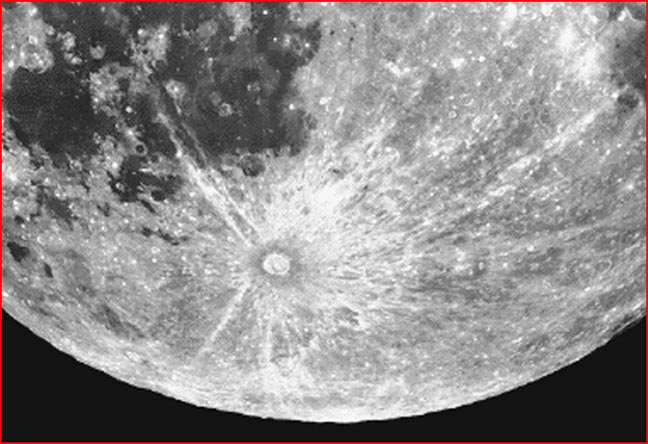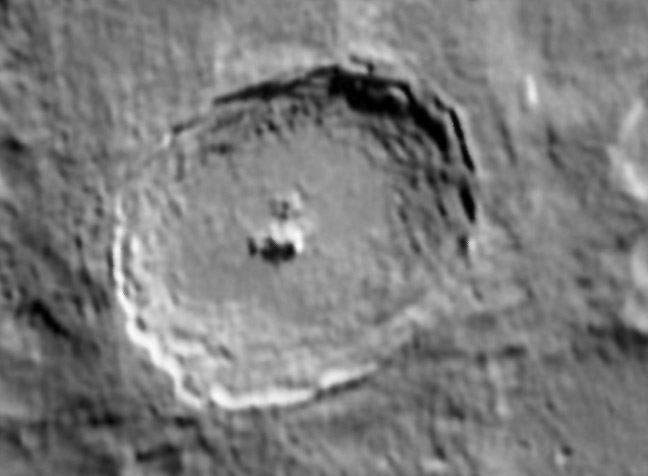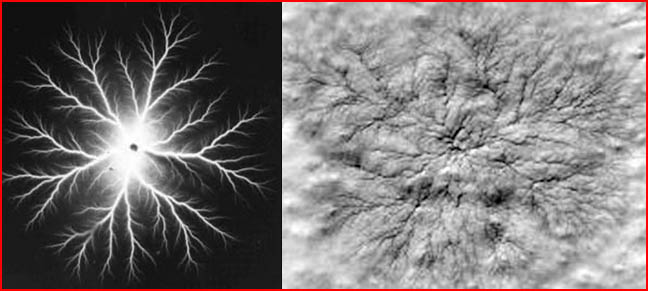Skip to comments.
NASA Spots Mysterious 'Spider' on Mercury
NASA Spots Mysterious 'Spider' on Mercury ^
| 30 January 2008, 3:54 pm ET
| Clara Moskowitz
Posted on 01/31/2008 3:31:16 PM PST by Excuse_My_Bellicosity
A whole new side of Mercury has been revealed in pictures taken by NASA's MESSENGER probe, which flew by the tiny planet two weeks ago in the first mission to Mercury in more than three decades.
MESSENGER skimmed only 124 miles (200 kilometers) over Mercury's surface on Jan. 14, in the first of three passes it will make before settling into orbit March 18, 2011.
The photos, released today, include one of a feature the scientists informally call "the spider," which appears to be an impact crater surrounded by more than 50 cracks in the surface radiating from its center.
Scientists are perplexed by this structure, which is unlike anything observed elsewhere in the solar system.
"It's a real mystery, a very unexpected find," said Louise Prockter, an instrument scientist at the Johns Hopkins University Applied Physics Laboratory, which built the probe for the $446 million NASA mission. She said whatever event created the spider "is anybody's guess," but suggested perhaps a volcanic intrusion beneath the planet's surface led to the formation of the troughs.
The last time NASA sent a probe to Mercury was in 1975, when the Mariner 10 spacecraft flew by the planet three times. MESSENGER'S first flyby gave scientists the first glimpses of Mercury's hidden side, the 55 percent of its surface that was left uncharted by Mariner 10.
MESSENGER, short for MErcury Surface, Space ENvironment, GEochemistry, and Ranging, also measured another peculiar element of Mercury — its magnetic field. Earth has a magnetic field surrounding it that acts as a protective bubble shielding the surface from cosmic rays and solar storms. But scientists were shocked when Mariner 10 discovered a magnetic field at Mercury, too.
"The only other example in our solar system of an Earth-like magnetosphere is tiny Mercury," said Sean C. Solomon, MESSENGER Principal Investigator from the Carnegie Institution of Washington.
MESSENGER was able to fly through the magnetic field and take detailed measurements that scientists hope to use to discover the origins of the inexplicable magnetosphere.
Scientists have been poring over more than 1,200 new images sent by seven instruments on the probe, and they are excited to gain new insight into the composition of Mercury's surface, the planet's history, and where its atmosphere comes from.
"On the eve of the encounter I couldn't sleep at all," said Robert Strom, a MESSENGER science team member who also worked on the Mariner 10 mission. "I've waited 30 years for this. It didn't disappoint at all. I was astounded at the quality of these images. It dawned on me that this is a whole new planet that we're looking at."
The satellite will further probe Mercury's mysteries in a second pass over the planet in October, followed by a third flyby in September 2009.
The probe has traveled 4.9 billion miles (7.9 billion-kilometers) since it launched in August 2004. On its journey it soared by Earth once and Venus twice, offering gorgeous views of these planets as well. In 2011 MESSENGER will become the first spacecraft to orbit the closest planet to the Sun.
TOPICS: News/Current Events
KEYWORDS: catastrophism; mercury; nasa; solar; spider
Navigation: use the links below to view more comments.
first previous 1-20, 21-40, 41-45 last
To: Roccus; Clarinet_King
To: 75thOVI; aimhigh; Alice in Wonderland; AndrewC; aristotleman; Avoiding_Sulla; BenLurkin; Berosus; ..
42
posted on
08/29/2008 2:58:27 PM PDT
by
SunkenCiv
(https://secure.freerepublic.com/donate/_______Profile hasn't been updated since Friday, May 30, 2008)
To: Excuse_My_Bellicosity; All

It is not truly unique. Look at these Martian Spiders:

It actually also compares quite well with Tycho Crater on the Moon which is, under the electric universe theory, not an impact crater but an electric discharge "lightning" pimple—a huge one, but a lightning pimple none-the-less— with the striations approaching it the remnants of the underground paths of the amassing electrons as they rush to join the massive plasma arc leaving the moon.

Tycho Crater is raised above the surrounding terrain, and stria do not line up with point of impact.
Sharing another feature with the Mercurian Spider and laboratory created "Lightning Pimples", Tycho and the spider have a raised center peak.
Note the striations, that have always been explained as ejecta paths, do NOT point directly toward (or away from) the center of "impact." They cannot be ejecta paths which would follow a ballistic path directly away from the point of impact. Note also that the stria on the Mercury Spider also do not point directly away from the point of impact.

On the left: An electrical discharge to a negatively charged surface, recorded on a photographic plate. On the right: A Martian “spider.”
43
posted on
08/29/2008 8:43:11 PM PDT
by
Swordmaker
(Remember, the proper pronunciation of IE is "AAAAIIIIIEEEEEEE!)
To: rfp1234
Aspergillus Niger?
You racist.
44
posted on
08/29/2008 9:10:19 PM PDT
by
Nik Naym
(If Republicans are your problem, Democrats aren't the answer!)
To: Swordmaker
Cool! Yeah, I was kinda wondering how really unique the Mercury “spider” is. I was thinking that it was either volcanic or an asteroid hit from when the surface was still semi-molten, but I wouldn’t consider lightning (or other electrostatic discharge) a bad theory at all.
45
posted on
08/30/2008 6:50:59 AM PDT
by
Excuse_My_Bellicosity
(Liberals: can't live with them, can't ship them to Syria.)
Navigation: use the links below to view more comments.
first previous 1-20, 21-40, 41-45 last
Disclaimer:
Opinions posted on Free Republic are those of the individual
posters and do not necessarily represent the opinion of Free Republic or its
management. All materials posted herein are protected by copyright law and the
exemption for fair use of copyrighted works.
FreeRepublic.com is powered by software copyright 2000-2008 John Robinson





